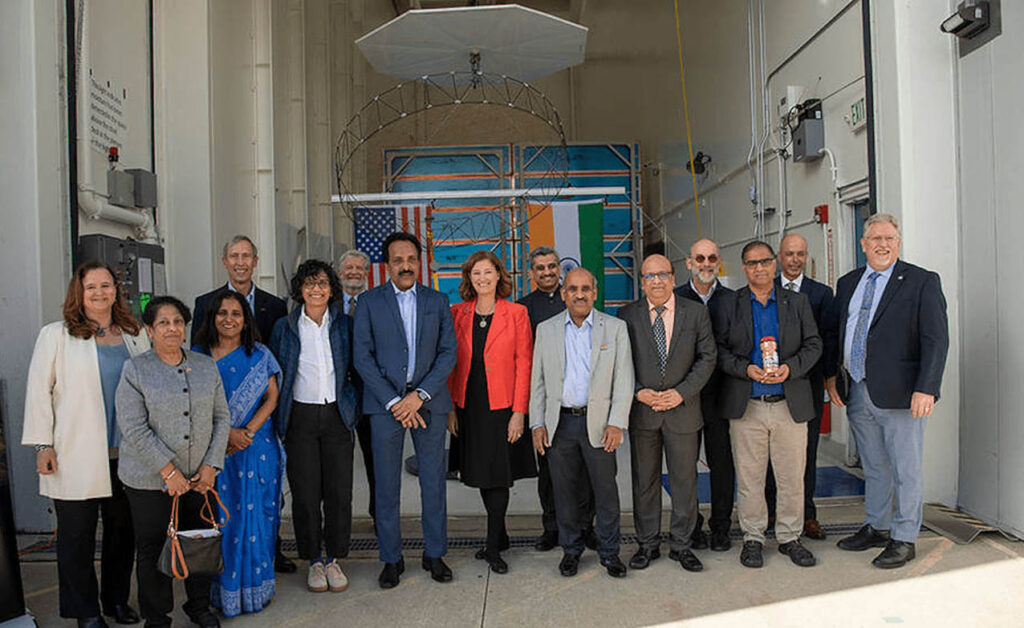INDO-US joint space mission NISAR to study and predict the natural processes and impending hazards on Earth.
- NISAR is the first-ever collaboration between NASA and ISRO on an Earth-observing mission.
- The total cost of the NASA-ISRO NISAR project is around USD 1.5 billion, which comes to around Rs. 12000 crores.
- Soon, teams at the Bengaluru facility will combine the radar systems with the satellite’s body, or bus, and run it through tests.
- This mission will be a powerful demonstration of the capability of radar as a science tool and help study Earth’s dynamic land and ice surfaces in greater detail than ever before.
- NISAR’s payload will be the most advanced radar system ever launched as part of a NASA science mission.
Bengaluru, March 11. The NISAR is set to be launched by ISRO’s, Geosynchronous Satellite Launch Vehicle Mark II rocket, scheduled to lift off in 2024 from the Satish Dhawan Space Centre in Sriharikota, Andhra Pradesh. The satellite will be placed into a near polar earth orbit.

Once in operation, NISAR will be able to collect measurements day and night, in all weather conditions, and its trove of data will help researchers better understand a broad range of earth sciences subjects, including landslides, groundwater loss and the carbon cycle.
The payload of the NISAR Earth science mission consists of two radar systems, one built by NASA and the other by the Indian Space Research Organisation (ISRO). The entire radar system was flown from NASA’s Jet Propulsion Laboratory in Southern California to Bengaluru on March 6.
Soon, teams at the Bengaluru facility will combine the radar systems with the satellite’s body, or bus, and run it through tests in advance of its three-year mission, according to the NASA.
The NISAR will feature the most advanced radar system ever launched on a NASA science mission. It will observe nearly all of Earth’s land and ice surfaces twice every 12 days, measuring movements in minute detail. It will also help study natural hazards, melting sea ice, groundwater supply, and more.
It will also survey forests and agricultural regions to help scientists understand carbon exchange between plants and the atmosphere.
“This mission will be a powerful demonstration of the capability of radar as a science tool and help us study Earth’s dynamic land and ice surfaces in greater detail than ever before,” Dr. Somanath, Chairman of ISRO observed recently.
NISAR’s payload will be the most advanced radar system ever launched as part of a NASA science mission. It will feature the largest-ever radar antenna of its kind: a drum-shaped, wire mesh reflector nearly 40 feet (12 meters) in diameter that will extend from a 30-foot (9-meter).
The mission’s science instruments consist of L and S band radar, which indicate the wavelengths of their signals.
ISRO built the S-band radar, which it shipped to JPL in March 2021. Engineers at the US Centre spent around two years integrating the instrument with the JPL-built L-band system then conducting tests to verify they work well together.
In late February 2023, technicians and engineers working in a JPL clean room put the science payload into a specially designed shipping container before hoisting it onto a flatbed truck for the drive to March Air Reserve Base in California’s Riverside County.
A U.S. Air Force C-17 cargo plane carried it from there to Bengaluru, touching down on March 6.
NISAR is the first-ever collaboration between NASA and ISRO on an Earth-observing mission. JPL, which is managed for NASA by Caltech in Pasadena, leads the U.S. component of the project and is providing the mission’s L-band SAR.
NASA is also providing the radar reflector antenna, the deployable boom, a high-rate communication subsystem for science data, GPS receivers, a solid-state recorder, and payload data subsystem.
On the other hand the ISRO is providing the spacecraft bus, the S-band SAR, the launch vehicle, and associated launch services and satellite mission operations.
On Sept. 30, 2014, NASA Administrator, Charles Bolden and ISRO Chairman, K. Radhakrishnan had first signed a partnership to collaborate on and launch NISAR and establish a pathway for future joint missions to explore Mars.





